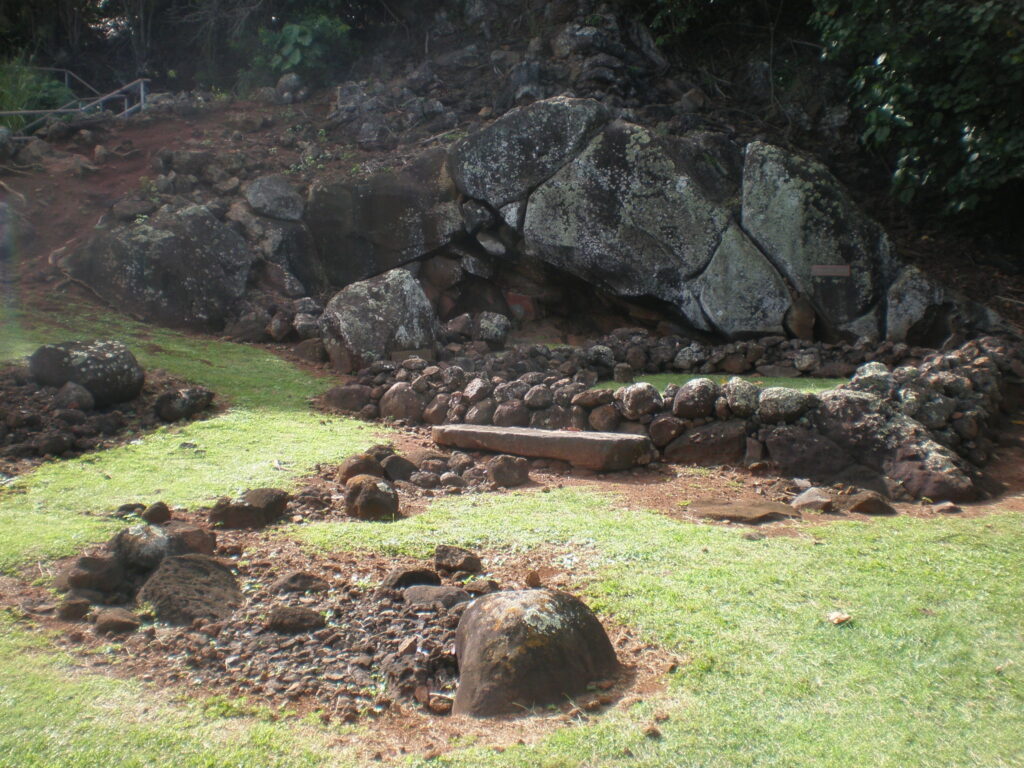Captain James Cook’s crew first sighted the Hawaiian Islands in the dawn hours of January 18, 1778. His two ships, the HMS Resolution and the HMS Discovery, were kept at bay by the weather until the next day when they approached Kauai’s southeast coast.
Cook sailed along the coast searching for a suitable anchorage. His two ships remained offshore, but a few Hawaiians were allowed to come on board on the morning of January 20, before Cook continued on in search of a safe harbor. On the afternoon of January 20, 1778, Cook anchored his ships near the mouth of the Waimea River on Kauai’s southwestern shore.
At the time of Cook’s arrival, the Hawaiian Islands were divided into four kingdoms: (1) the island of Hawaiʻi under the rule of Kalaniʻōpuʻu, who also had possession of the Hāna district of east Maui; (2) Maui (except the Hāna district,) Molokai, Lānaʻi and Kahoʻolawe, ruled by Kahekili; (3) Oʻahu, under the rule of Kahahana; and at (4) Kauai and Niʻihau, Kamakahelei was ruler.
Of the four, Kamakahelei was the only woman.
Kamakahelei was the “queen of Kauai and Niʻihau, and her husband was a younger brother to Kahekili, while she was related to the royal family of Hawaiʻi. Thus, it will be seen, the reigning families of the several islands of the group were all related to each other, as well by marriage as by blood. So had it been for many generations. But their wars with each other were none the less vindictive because of their kinship, or attended with less of barbarity in their hours of triumph.” (Kalākaua)
“At that time Kahekili was plotting for the downfall of Kahahana and the seizure of Oʻahu and Molokai, and the queen of Kauai was disposed to assist him in these enterprises.” (Kalākaua)”
The occupation of the Hana district of Maui by the kings of Hawaii had been the cause of many stubborn conflicts between the chivalry of the two islands, and when Captain Cook first landed on Hawaii he found the king of that island absent on another warlike expedition to Maui, intent upon avenging his defeat of two years before, when his famous brigade of eight hundred nobles was hewn in pieces.” (Kalākaua)
“The native historians all say that on the night that Cook’s ships anchored at Waimea, a grand council was held at the house of Kamakahelei, the highest chiefess on the island, and the actual hereditary sovereign of that part of Kauai, when some proposed to seize the ships by force and run them ashore for the sake of the plunder that would be obtained …”
“… while others of a more pacific or more timid mind proposed to propitiate the newcomers – whom, or rather whose captain, they in some confused manner connected with the old and distorted legend of Lono – with presents and with the charms of their women.” (Fornander)
“The latter advice was acted on, and hogs, vegetables, kapa, and women were sent on board, and among the latter was Kamakahelei’s own daughter, Lelemahaalani; and during the last generation of Hawaiians it was openly said, and never contradicted, that that night Lelemahoalani slept with Lono (Cook.)” (Fornander)
Surgeon Ellis, who was part of Cook’s crew, stated in 1779 that Kamakahelei “was short and lusty, about 40 years of age, and very plain with respect to person.” That would make Kamakahelei’s birth around 1739.
Kamakahelei was the only daughter of High Chief Kaumeheiwa (the son of High Chief Lonoikahaupu and High Chiefess Kamuokaumeheiwa) and his wife, High Chief Kaʻapuwai (possibly the daughter of Peleioholani, 22nd Alii ʻAimoku of Oahu and 21st Alii ʻAimoku of Kauai.)
Kamakahelei succeeded Peleioholani as the Aliʻi of Kauai.
Kamakahelei was believed to possess a secret, most powerful and sacred prayer, greatly feared throughout Hawai‘i, called the “Aneekapuahi,” which could cause an enemy’s immediate incineration – it was feared throughout the Islands.
Kamakahelei’s first husband was Kaneoneo (Peleʻioholani’s grandson.) With Kaneoneo, Kamakahelei had two daughters, one of whom, Kapuaʻamohu, became one of the wives of Kaumualiʻi and grandmother of Queen Kapiʻolani.
Her husband’s father, Kūmahana, was desposed by the ʻEwa chiefs who replaced him with Kahahana, who would become the last king of Oʻahu. Kaneoneo died during the rebellion on Oʻahu against Kahekili about 1785-6.
At the time of Cook’s visit, Kamakahelei had another husband, the celebrated Kāʻeokūlani ((Kāʻeo) younger brother of Kahekili, Mōʻi of Maui.)
With Kāʻeokūlani, Kamakahelei had a son Kaumualiʻi. Kaumualiʻi was born at Holoholokū Heiau in Wailua. (Like its counterpart Kūkaniloko heiau in Wahiawa, Oʻahu, these royal birthing sites maintained the antiquity and purity of the chiefly lineages on O‘ahu and Kauai. It is said that chiefs from Hawai‘i Island and Maui often sought greater prestige by marrying those with these strong ancestral lineages.)
Her second husband, Kāʻeokūlani, died on Oʻahu in 1794, but the time of her own death has not been remembered, but it probably occurred shortly after that of Kāʻeo. (Fornander)
At his mother’s death, Kaumualiʻi became the sovereign of Kauai, and, though young in years, appears from all descriptions to have been a prince of remarkable talents and a most amiable temper. (Fornander)
In the face of the threat of a further invasion, in 1810, at Pākākā on Oʻahu, negotiations between King Kaumuali‘i and Kamehameha I took place and Kaumualiʻi yielded to Kamehameha. The agreement marked the end of war and thoughts of war across the islands.















